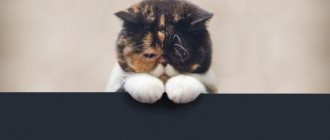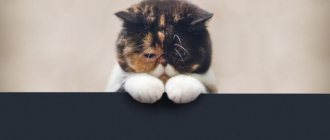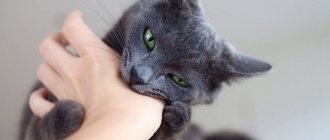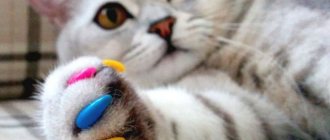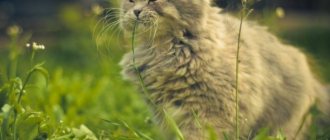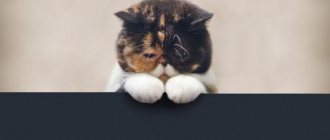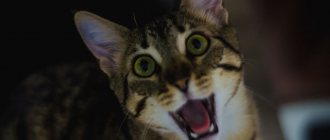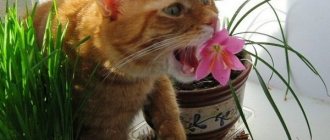How nice it is to hear purring, stroke a soft belly and watch your cat play. Pets touch the soul, give positivity and a feeling of comfort. In addition to moral satisfaction, little tigers treat their owners, feel them subtly and detect even minimal mood swings.
But sometimes a peaceful life together with a cat is crossed out by his dirty tricks. He may shit in shoes, dig through flower pots, gnaw on his favorite indoor flower, or scratch furniture. How to raise a pet and save your home?
Why does a cat dig in flowers?
An animal does nasty things not just out of spite, but under the influence of instincts. Cats in nature dig the ground in search of edible grass, roots, in order to relieve themselves.
In an apartment they are deprived of this opportunity and may try to compensate for it.
The cat digs a flower pot for a reason:
- Dirty tray. Felines are extremely clean creatures. A dirty toilet can push your pet to search for a suitable place. The cat's litter box should always be clean, otherwise you can expect “surprises” not only in flowers.
- Uncomfortable filler granules. They may be too large or smell unpleasant. Try replacing them with others or installing a new tray. If the animal walks on the net, pour it with fine litter and remove it.
- Lack of vitamins. If a cat not only digs, but also gnaws on plants, he is lacking plant components. On the street they choose and eat wild grass, but at home this is impossible. Buy sprouted vegetation for cats at the pet store. Perhaps this will solve the problem.
- Curiosity. Pots are often placed on window sills, and the windows offer a view of an interesting, vibrant life. If your pet is curious, give him some space.
Which plants are dangerous for pets?
There are quite a lot of houseplants that are harmful to the health of cats, and in order to cause gastrointestinal disorders and other troubles, pets don’t even need to taste the flower - it’s enough for the juice or pollen to get on the fur or skin. Of particular danger are azalea, dieffenbachia, cyclamen and other flowers, loved by many breeders of cats and other animals.
The beautiful poinsettia is deadly to cats
Table 1. Houseplants harmful to animals.
| Plant | Harmful parts of the plant | Why is it dangerous? |
| Azalea | All parts of the plant | Includes an alkaloid that has a depressant effect on the activity of the central nervous system, causing vomiting, drowsiness, swelling of the throat, convulsions, |
| Scheffeler | Leaves | The juice of the plant has a toxic effect not only on animals, but also on people, and contributes to irritation of mucous membranes and the development of allergic reactions, including Quincke's edema |
| Diefenbachia | ||
| Cyclamen | Stems and leaves | Causes serious poisoning and intoxication, and in case of overdose (if the animal eats too much of the plant) it can be fatal |
| Chrysanthemum | Leaves | A small amount of greens eaten leads to mild illness, a large amount leads to serious poisoning. |
| Almost all climbing plants, especially ivy | ||
| Philodendron | Flowers, leaves | Toxic chemical compounds that are part of greens are a strong allergen that can cause anaphylactic shock. A small amount of juice, if ingested, disrupts kidney function and can lead to chronic dysfunction of the urinary system. |
| Caladium | ||
| Monstera | Leaves | The leaves of a huge palm tree have small needles that cause a strong burning sensation, and in cats sensitive to allergens, they can provoke unwanted reactions in the body. |
| Representatives of the euphorbia family (croton, euphorbia, akalifa) | All parts | Such plants contain a component called euphorbin, which disrupts the functioning of many organs and systems - ulcers and skin lesions that do not heal for a long time, inflammatory processes in the mucous membranes of the mouth and eyes, which can lead to complete loss of vision, disruption of the digestive tract and CNS |
| Flowers of the Kutrov family (oleander, adenium, pachypodium, allamanda) | All parts | The juice of kutrovye plants contains components that contribute to disruption of the cardiovascular and nervous systems. |
| Ficus | All parts | Causes oral irritation and dermatitis |
| Narcissus | All parts | They provoke poisoning of the body, accompanied by the following symptoms: disturbances in the functioning of the stomach, cramps, muscle and abdominal pain, and in case of serious complications - dysfunction of the lungs, heart, kidneys |
| Physalis | ||
| Asparagus | ||
| Lily | Leaves and flowers | Contributes to swelling of the mucous membranes, loss of coordination of movements, dysfunction of the cardiac system |
| Hydrangea | Flowers | The chemical composition of hydrangea contains cyanide, which causes urinary and cardiovascular problems. |
Cacti, including small ones, are also considered potentially dangerous for cats - curious animals can injure their tongues or paws on their spines. Do not forget that not only indoor flowers, but also ordinary street flowers are potentially harmful to the cat’s body. In addition to the natural poisons and toxins found in many plants, chemicals used in specialized stores to make flowers last longer and grow better can harm a cat’s health.
In addition, if an animal drinks water from a container where flowers have been standing for a long time, it may experience an upset stomach and other unpleasant symptoms - microbes quickly multiply in the liquid, which, when swallowed, enter the cat’s body.
It’s also better to keep cacti away from cats.
Many plants that can cause poisoning and serious illness in cats are unpleasant to the taste and burn the mouth, so pets rarely eat large quantities of leaves or flowers. But even a small dose of the toxin can cause unpleasant consequences and symptoms that require consultation with a veterinarian.
Attention! Many indoor plants that are dangerous for cats can also harm people (especially small children), so not only pet owners, but everyone without exception, should be careful when choosing flowers.
Out of range
You can move flower pots out of reach. Of course, cats will climb anywhere, but the method may work.
Pots on window sills need to be hung or raised on special stands. They are sold in flower and hardware stores. Greenery on cabinets is easier to save: remove everything underneath that can be climbed up.
Close the plantings in one room and keep the animal out. Due to his natural curiosity, he will use cunning to try to penetrate inaccessible territory. But if everyone in the household closes the door, the cat will be left with nothing.
Consequences of eating houseplants
Beginners and inexperienced owners note the damage caused to flowers, but veterinarians recommend paying attention to the health of their furry friend. If flowers are more important, and chewing plant leaves causes an attack of anger, you should not get a cat. Getting to know indoor flowers most often ends in failure:
- Gastrointestinal tract. Vomiting, excessive salivation, diarrhea. Symptoms may not develop immediately, but within 24 hours after eating the flowers.
- Nervous system. Some plants cause partial paralysis and stiffness of movement.
- Respiratory system. Difficulty breathing, asthma attacks.
The danger of eating house flowers is that toxins can accumulate without causing an immediate reaction. If the body is extensively damaged, it is difficult to prescribe effective therapy, so it is better to prevent an accident.
Was the article helpful? Rate her
Block
Protect indoor flowers from the mustachioed robber. This can help:
- Foil. Cats do not like extraneous sounds, so foil rustling under their paws can scare away the furry pest. Cover the window sill with her and watch the kitty's actions.
- Double-sided tape. A sticky surface will not please a clean animal. Sticky fur will be annoying, and you will see if there were any attempts to grab the pots.
- Water. Fill a spray bottle with liquid and give the impudent barbarian a cold shower. Meeting water will quickly sober up the cat. But the process will need to be repeated several times, catching the robber in the act.
Why is a cat's interest in potted plants dangerous?
Your mustachioed pet needs to be discouraged from eating flowers as soon as possible. Otherwise, this can lead to acute intoxication, accompanied by:
- loss of appetite;
- prolonged diarrhea and vomiting;
- severe dehydration of the body;
- damage to mucous membranes;
- general weakness, convulsions and coma.
Similar symptoms are typical when eating poisonous plants and can be fatal. When choosing house flowers, be sure to check their compatibility with the cat family.
Strong odors
A naturally developed sense of smell allows cats to accurately find food and survive in nature. But this can also help when raising a pet. For example, place citrus zests and peels next to your pots. They will fill the room with a pleasant aroma and scare away the striped one. Onions and garlic work on the same principle. True, they also give dubious pleasure to humans.
You can smear the outer surface of the pots with “Zvezdochka” balm or Vishnevsky ointment. The pungent smell will make you forget about your favorite activity.
But essential oils will benefit people and save plantings. A couple of drops can be applied to pots and the surface of the windowsill. An aroma lamp placed near the flowers is perfect. Choose a scent to suit your taste: lemon will invigorate, lavender will soothe, and green tea will calm.
How to stop a cat from climbing into flower pots in the house
Cats have different skills and natural instincts, one of which is their love of digging. Outdoor animals satisfy their need in flower beds, but pets are especially attracted to pots of indoor plants on the window. How to stop a cat from climbing into flower pots is a very pressing question for many owners of domestic cats who are addicted to tearing up green spaces and shitting in pots with soil.
Isolating flowers in the house, hiding access to them for your furry pet, is not an option. A more correct solution to the problem in this case is to raise a cat using small tricks, which we will talk about in our article today!
Saving flowers by scaring them away
If it is not possible to move the flowerpots, it is worth using their main trump card against cats - their keen sense of smell. Being owners of a sensitive sense of smell, furry friends do not really tolerate strong odors. We tell you how this property can be used to save plants:
- Regularly treat flowers with special sprays from the pet store.
- Make scent bombs: place cotton wool soaked in vinegar, alcohol and citrus essential oil near the flowers.
- Place dried lavender in pots.
- Place saucers with fresh lemon zest, red pepper and cinnamon essential oil.
- Dilute flower pots with pots of herbs.
It is worth considering that aromatic products have a short-term effect. It is most advisable to use them for raising kittens in order to initially discourage interest in flowers.
Other reasons
One of the reasons cats chew or pull flowers out of pots is obsessive-compulsive disorder. Does your pet, when stressed, chew on a blanket or a stuffed bunny's ear, a rag, or your fancy dress? This is a clear sign of obsessive-compulsive neurosis. Most often, such a disorder occurs in Abyssinians, Burmese or Siamese, and less often in exotics. It is very difficult to cope with it on your own, and in some cases it is even impossible, so the best thing you can do in this case is to seek help from a qualified animal psychologist.
Your cat eats what can only be conditionally called edible, giving preference to:
- newspapers;
- wallpaper;
- plaster;
- electrical cords;
- jute twine
With a high degree of probability, we can assume that your pet has pararexia - a perversion of taste. The cause of this phenomenon can be genetic predisposition, severe stress, emotional stress, and congenital anomalies. We should not forget that an animal’s pathological addiction to inedible objects can pose a serious danger to its health and even lead to truly tragic consequences. Poisoning, intoxication, blockage of the intestinal lumen and damage to the mucous membrane of the digestive tract, which can be caused by blockage of the intestinal lumen by foreign objects, are a common result of such a disorder. Therefore, if your pet has an unhealthy addiction to houseplants that is not associated with hypovitaminosis or constipation, the best thing you can do is leave two or three flowers in the house that do not pose a danger to the animal, or get rid of all plants.
Repellent orange peels
The smell of citrus fruits is one of the least favorite for the cat family. I have long noticed that our favorite avoids the New Year's table. But the point turns out to be this: an abundance of oranges and tangerines. How can they help protect flowers from being eaten? Very simple. You need to spread orange (tangerine) peels around indoor flowers. If citrus fruits are not in season, a colleague advised using vinegar. You need to saturate the cotton wool with it and put it in the pot. True, this smell also scares me away. But in order to save your favorite flower, you can endure a little. Over time, the vinegar disappears, and the cat is re-educated.
We recommend: How to quickly and correctly germinate a tangerine seed at home?
Scotch fencing
Scotch tape is one of the most powerful weapons against cats.
I have not yet met an animal that would treat him calmly. One day, my Musya accidentally ran her tail across the table (she was gluing a craft for a child in the garden), and she wrapped herself all in adhesive tape. Oh, and she jumped. She jumped around like crazy. We nearly burst our stomachs from laughing. Since then he has looked at tape with caution. A sticky fence will quickly teach your mustachioed pet not to go into forbidden places. Can:
- Cover the perimeter of the pots with tape (to create a kind of fencing for the flower garden).
- Place strips of tape on the ground and between the pots.
Naturally, the sticky side should face outward. To prevent the tape from falling, you need to stick it along the edges with small squares of adhesive tape. I do not recommend using double-sided tape. It will leave marks that will take a long time to wash off. At one time these methods helped me a lot. Musya stopped spoiling the flowers, and now they coexist peacefully. Here you need to try different things. All cats are unpredictable and have their own personalities. Some people will be put off by the usual orange peel, while others will not care at all: they will throw the cactus off the windowsill, remove the protective cover from the pot, and tear the tulle to shreds. A colleague told me about such a pet. In the end, they moved all the flowers to the loggia, but the cat was not allowed there under any pretext.
